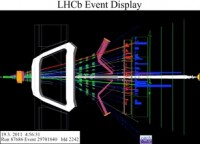Discovery of a new matter-antimatter difference

The LHCb experiment has observed a matter-antimatter difference in the neutral Bs meson system. This effect is important to our understanding of the absence of antimatter in the Universe.
The universe we live in consists of matter, but scientists assume that in the beginning, the big bang created equal amounts of matter and anti-matter. The absence of anti-matter in the Universe requires that there are differences in the behaviour of matter and anti-matter (CP violation). A new discovery by the LHCb experiment means scientists have taken a further in understanding the difference between matter and anti-matter.
The Large Hadron Collider beauty (LHCb) experiment is designed to look for the small differences between matter and antimatter in the particles produced in collisions at the Large Hadron Collider (LHC) at CERN, Geneva. At the LHC we are colliding protons onto protons head on, thereby recreating the conditions as they existed 10-12 seconds after the Big Bang. Differences between matter and anti-matter are probed by studying the properties of particles called mesons that contain two bound quarks. Four neutral meson systems are possible in nature, named the K0, D0, B0 and Bs. CP Violation is already well known in two of these: the first observation of CP violation was made in 1964 in the neutral kaon (K0) system, a discovery that led to the 1980 Nobel prize. The later discovery of CP violation in the B0 system confirmed the theoretical description of the phenomenon and led to the 2008 Nobel prize. Now this behaviour has also been observed in Bs mesons, states made from beauty and strange quarks and antiquarks.
In this measurement of CP violation effects, scientists look at two variants of a decay of the Bs meson, namely the decay to the final state K-π+ (a negatively charged kaon and a positively charged pion) and its “mirror image” final state K+π- where all particles are replaced by their antiparticles (a positively charged kaon and a negatively charged pion). A small difference in the rates at which these two decay modes happen, indicates CP violation, a difference in the behaviour of matter and antimatter.
LHCb first found a hint for CP violation in the decay of Bs mesons in March 2012 with the analysis of a third of the data sample collected in 2011. Now the full sample from 2011 has been scrutinised and the analysis refined. The confirmation of the previous measurement and discovery of CP violation in the Bs is based on analysis of 70 trillion proton-proton collisions. The data contains approximately one thousand Bs → π K decays in which a difference between the rate of decays to the final state K-π+ and its CP mirror image K+π- is observed with a significance exceeding 5 sigma, the standard criterion for discovery. The measurement relies on the ability of the experiment to accurately distinguish between pions and kaons using photodetectors that were tested and qualified at the Universities of Edinburgh and Glasgow.
"This is an important measurement and step forward in our understanding of the puzzle of the missing anti-matter in our Universe.", says Prof. Franz Muheim, University of Edinburgh, who led the photodetector test programme, "The performance of the detector so far has already exceeded our expectations. This is testament to the work that went into the design, testing, commissioning and monitoring of these photon detectors by a team of physicists, PhD students, engineers and technicians at the University of Edinburgh and partner institutes in the LHCb collaboration". The measurements made by LHCb are in agreement with the Standard Model of particle physics which allows CP violation to occur but not at the level needed to explain the matter and antimatter difference of the Universe. Prof. Muheim added "The fact the Standard Model fails so spectacularly in explaining the absence of antimatter remains an unsolved puzzle and hints at new physics. That is what LHCb was designed to find and we are making important steps on that road thanks to the good performance of both the LHC and our detector."

